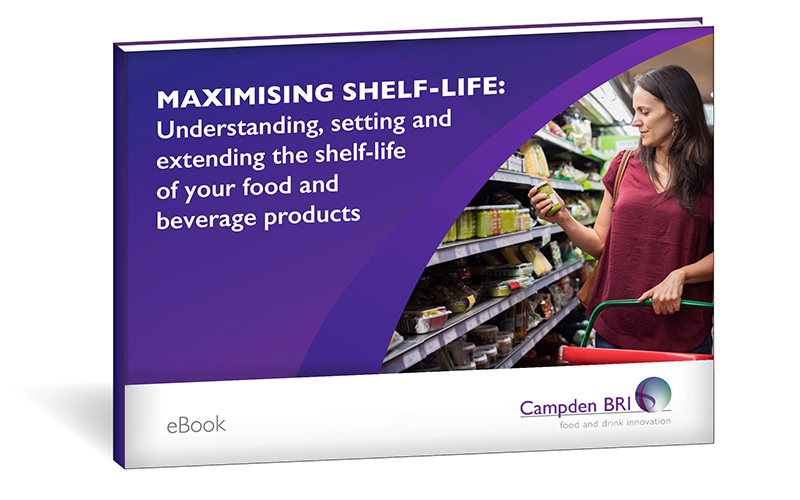
Accelerated shelf-life testing of food and beverage products
26 March 2025 | Bijol Bakhai, Processing and Storage Food Chemist, and Linda Everis, Section Lead - Microbiology Safety and Spoilage
Shelf-life and shelf-life testing
Many sensory, chemical, physical and microbiological attributes of food and beverage products will change over time after the product is made / packed. Food and beverage product shelf-life is the amount of time that a particular product remains safe and acceptable to consume, and may range from a few days to several months depending on the product category.
As part of determining a product’s shelf-life, many attributes may be monitored over the time period of the intended shelf-life.
Some of the attributes typically measured for shelf-life testing are:
- levels of microorganisms
- whether a product can support the growth of pathogens or the formation of microbial toxins under the intended storage conditions
- changes in sensory quality characteristics
- changes in texture / structural properties
- the effect of different packaging formats
Download the complete Maximising Shelf-life eBook, for free, to unlock the tools for measuring and maximising the shelf-life of your food and drink products whilst ensuring their safety and quality.

To ensure safe product for the consumer, great care must be taken when designing a shelf-life validation / testing plan, analysing shelf-life data and setting an appropriate shelf-life for a new product or shelf-life extension.
For many products and their shelf-life testing, there is often a desire to accelerate the testing through the aptly named ‘accelerated shelf-life testing’ (ASLT). Here we cover some considerations and limitations for conducting accelerated shelf-life testing, as well as outlining some of the services we offer in this area and signposting other tools that you may find useful.
Accelerated shelf-life testing – what is it and why perform it?
In Accelerated shelf-life trials, the storage conditions are altered from normal conditions to speed up some of the deterioration processes and other changes that normally occur over the course of the product’s storage period / shelf-life.
For products with a long shelf-life, e.g. 12+ months, it is not always practicable to carry out real time storage trials as this would delay the time to product launch. As such, there is a need to speed up the shelf-life testing process in order to get a quicker indication of the likely shelf-life of the product.
...not all relevant microorganism growth and chemical reactions will speed up at the same rate
For which products can accelerated shelf-life testing be performed?
Accelerated shelf-life testing should not be used to determine microbiological safe shelf-life, i.e. it should not be applied to products where there is a microbiological safety risk. Perishable foods with a ‘Use by’ date should be tested under normal storage conditions (representative of how the product will be stored in practice in ‘real life’) in real time. This is because changes to storage temperatures may alter the growth of important groups of microorganisms; not all relevant microorganism growth and chemical reactions will speed up at the same rate . What’s more, not only could microorganism levels appear to be different but the altered storage temperature could even cause the types of microorganisms present to be different too.
Accelerated shelf-life testing can however be applied, to varying extents, to a wide range of ambient products and dry products. Accelerated testing can even be offered for frozen products if the client supplies the storage trial conditions to be applied to the product.
We currently apply accelerated shelf-life testing most commonly to shelf stable products, such as canned foods, dry products, UHT milk, and high acidity sauces. Dry snacks and baked goods, for example, are often good candidates for accelerated shelf-life testing – products such as biscuits, snack bars, savoury snacks, powders, cakes and coffee powder can be stored under a range of storage conditions and the products tested for changes in agreed parameters.
Even for products where accelerated shelf-life testing is applicable, open shelf-life testing should be conducted under standard, real time storage conditions instead of accelerated.
Ways of conducting accelerated shelf-life testing
Increased storage temperature is generally used as the ‘abuse’ / accelerating storage condition and there are mathematical models, such as the Arrhenius model, that we can use to link the storage temperature to the rate of many chemical reactions and product deterioration processes.
Other abuse conditions include, for example:
- higher humidity – where a product or packaging is susceptible to an increase in moisture
- high oxygen – where a high-fat product is susceptible to oxidative processes
- increased light exposure – for products that are light sensitive
Getting the most out of your testing
To get the most useful data out of accelerated shelf-life testing, we would also strongly recommend running these tests in parallel with real time storage conditions. Or we would suggest testing a new product alongside a similar ‘control’ product that has already undergone real time testing. Side-by-side testing of the control and test products at different elevated temperatures would be performed.
For any accelerated testing it must be proven that the acceleration methods used are valid
Proceed with caution
Whilst storing products under accelerating conditions may speed up some deterioration processes and give a broad indication of likely changes under normal conditions, the use of accelerated shelf-life testing can alter the relative speed of different changes as well as force other changes to take place that would not normally occur under normal storage conditions. Accelerated storage trial results should therefore be used with extreme caution.
For any accelerated testing it must be proven that the acceleration methods used are valid. This can be done by modelling the comparisons of accelerated and real time data. Unless there is sufficient existing data from equivalent products to prove that your accelerated timeframe is applicable for modelling the full shelf-life of your product, its shelf-life will also have to be measured in real time.
Other tools to predict changes over time
There are a number of predictive tools that can be used to give an indication of the shelf-life under different storage conditions. For predictive microbiology we have the Campden BRI Forecast predictions for spoilage microorganisms and there are the ComBase and pathogen modelling programmes available online for modelling growth of pathogens. These can be used to predict the likely changes in microbial levels over usual or abuse conditions.
For baked goods we have ERH-calc Mould Free Shelf-life tools to predict the likely shelf-life of baked goods based on their formulation.
We can help you with shelf-life
We provide tailored, expert support in all areas of shelf-life evaluation, maximisation and extension, and have specific expertise in microbiology, chemistry, sensory, regulatory and product innovation services. As well as guidance, analysis and support with interpretation, we also store samples for clients under the conditions required for their specific real time and accelerated shelf-life trials.
We have more than 200 scientists and technical experts collaborating on a wide range of projects every day. Get in touch if you’d like their support with a shelf-life project.

About Linda Everis
Linda has a wealth of knowledge, experience and expertise from her time in Microbiological Analytical Services and Microbiology Safety and Spoilage. She joined Campden BRI in 1995 as a Senior Technician in the Microbiological Analytical Services group having graduated from the University of Wales Aberystwyth with a BSc in Biology.
Alongside the expert support that Linda provides to our members and clients, Linda conducts project work and research, and has been author and co-author of articles and papers for a variety of microbiological publications and Campden BRI reports.
Linda also lectures on shelf-life, challenge testing and predictive microbiology for our many training courses and seminars.
How can we help?
For guidance and practical support with standard or accelerated shelf-life testing, get in touch.
Download our FREE Maximising Shelf-life eBook today!
Explore different strategies to maximise and extend product shelf-life, without compromising safety or quality.
This blog was first published in 27 April 2023






